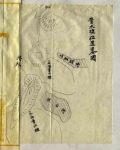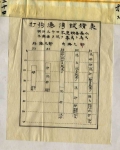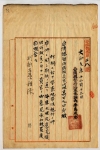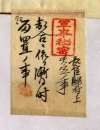TELDAP Collections
| Port of Kaohsiung |
Formerly named Takau Port, the Port of Kaohsiung is the most important commercial harbor in southern Taiwan. Early into the Japanese rule, there were already deliberations on constructing a modern harbor on the site of Takau Port, since the original port suffered from shallow drafts, high reefs, and a lagoon at its perimeter. The construction project started in 1908 on a budget of 4,735,000 yuan; however, after going through several revisions and expansion, by 1931 a total of 24,735,000 yuan had already been spent. It wasn’t until 1937 that the project was set to due. The major player in the construction of Kaohsiung Port was an engineer at the Civil Bureau of Taiwan Sotokufu (Taiwan Governor-General Office) named Kojiro Kawakami, who presented a comprehensive report in September 1906 detailing the planning process (figure1, figure2). Back in 1899, when Kawakami accompanied Goto Shinpei, Head of Civilian Affairs, on a visit around southern Taiwan, he investigated the topography of the Takau Port and saw the need for renovation. Kawakami then proposed three ways to carry out the project (figure 3). However, understanding that the success of a harbor construction project hinged upon careful assessments prior to construction, a comprehensive survey was undertaken from June 1900 to March 1904 (figure4, figure5). This included topographic surveys, ocean depth measurement, observations on tidal patterns, meteorological phenomena, ocean currents, submarine geology, wave height, wave length, wave energy, movement of silt and sea-level platforms as well as surveys of materials found in surrounding areas (e.g. drinking water quality and stone) (figure6). The investigation report is complete with charts (figure7, figure8) and a bibliography (figure9, figure10), leaving valuable documentation on the natural history of Taiwan. In the section of meteorological observations, for example, the report includes records on atmospheric pressure, wind direction (figure11), temperature (figure12), humidity, precipitation and earthquakes (figure13). These documents reveal the extent to which the technocrats in Japan had contributed to the development of Taiwan.
Before the construction project took place, the port underwent a general overhaul to improve facilities (figure14), and 69,500 yuan was earmarked for the project in 1906 (figure15, figure16) (original estimates were 60,000 yuan)(figure17). The budget, which detailed all expenses, offers us a glance at the commodity price and wage levels of the period. During the construction, foreign ships were allowed to pass freely, yet the project required reforms on urban planning and imposed restrictions on the structures of building in the region. This was of concern to the Chief of the Maritime Staff, who suggested that the Vital Area Regulations should be applied to the Port of Kaohsiung (figure18, figure 19). The Head of Civil Affairs, however, felt that the construction plan was not applicable to the March 1902 Clause no.3, “Restrictions on Defensive Construction for National Defense of Taiwan,” and took the matter to the Minister of Engineering Affairs (figure20, figure21). The Minister agreed that the application of such regulations would hinder the construction of the commercial harbor (figure22, figure23), and his reply was later delivered to the Office of the Chief of the Maritime Staff (figure24). From the above, we see that the construction of Kaohsiung Port trigged a debate on whether economic development or national defense was paramount.
Original Chinese text and images are provied by Taiwan Historica and Institute of Taiwan History of Academia Sinica
|
|||||||||||||||||||||||||||||||||||||||||||||||||||



































